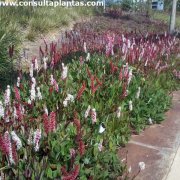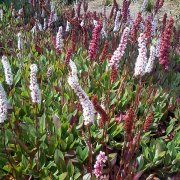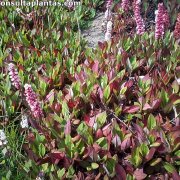Care of the plant Persicaria affinis or Lesser Knotweed |
|
The genus Persicaria, family Polygonaceae, comprises 100 species of herbaceous, perennial, and annual plants native to all continents. Some species are: Persicaria affinis, Persicaria capitata, Persicaria odorata, Persicaria bistorta, Persicaria maculosa, Persicaria lapathifolia, Persicaria amphibia. Common names: Lesser Knotweed, Persicaria. This species is native to the Himalayas. Scientific synonyms: Polygonum affine, Bistorta affinis. They are small herbaceous perennial plants of compact and creeping habit that reach 30 cm (11.8") in height. They have lanceolate leaves with a very marked central vein, first of a bright green color and, from autumn, of a reddish-bronze color. The flowers are very small but appear in showy pink or red cylindrical panicles. They bloom from mid-summer to mid-fall. Lesser Knotweed is used in flowerbeds, on borders, to cover slopes, next to ponds, and in pots and planters. Persicaria affinis grows in semi-shade and full sun exposures. It resists occasional frosts. The soil should be light, well drained, and contain organic matter. The transplant is done in any season and the planting can be done from mid-autumn to mid-spring. Water regularly so that the substrate is always slightly damp; Lesser Knotweed does not withstand drought. Fertilize with compost or manure in late winter or early spring. Prune lightly after flowering to maintain a compact appearance. It's important to control its invasive roots. Persicaria affinis is a resistant plant to the usual pests and diseases. Lesser Knotweed is propagated by division in spring or from seeds sown also in spring. |
Images of the plant Persicaria affinis or Lesser Knotweed |
Find plants
Persicaria affinis or Lesser Knotweed | Care
© 2025 FavThemes


